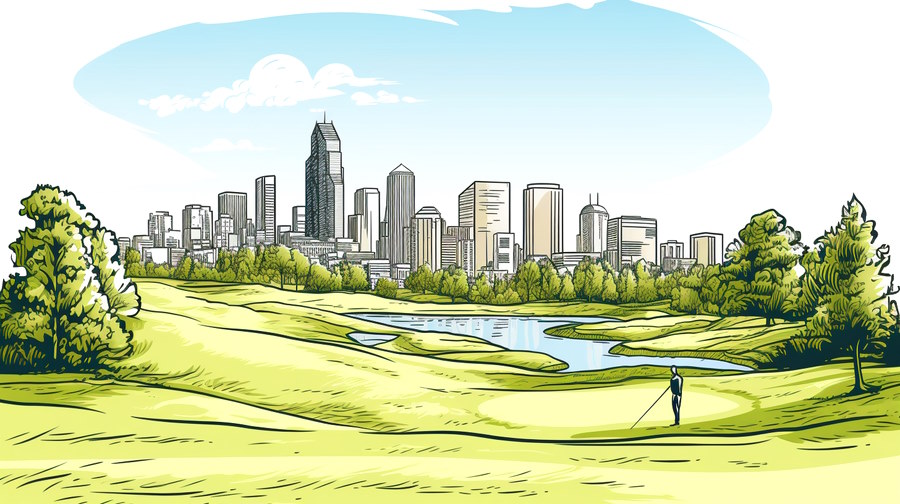Navigating the Golf Ball Rollback: Implications and Insights
What’s shaping the future of golf? A groundbreaking decision by the United States Golf Association (USGA) to limit the travel distance of golf balls, the golf ball rollback, aims to address some of the sport’s most pressing challenges.
This move is rooted in sustainability concerns and the desire to preserve the traditional essence of golf courses. And it reflects a significant shift towards balancing the game’s historic values with contemporary environmental considerations.

Through this initiative, the USGA seeks to mitigate the impact of course expansions—driven by the quest for greater drive distances—on both the environment and the sport’s economics. We will unpack the USGA’s decision. This article explores its implications for the future of golf and how it proposes to keep the sport enjoyable and relevant for coming generations.
Recommended:
- The Masters Experience: Spectator Tips and Essentials for 2024
- Couples Golfing Goals: How Couples of Today and Yesterday Bond Through Golf
- Integrating Technology in Golf: Revolutionizing the Game with Advanced Golf Balls and Simulators
- First Set Of Golf Clubs: Tips for Buying Your First Set of “Real” Golf Clubs
- The Key to Consistency: Choosing the Right Golf Iron Set for Your Game
- Summer Golf Apparel Guide: Stay Cool and Comfortable on the Course
Overview of the USGA Proposed Changes and Their Objectives
The United States Golf Association (USGA) has introduced significant changes to the golf ball testing standards aimed at reducing the distance that golf balls can travel. This adjustment is a strategic response to several challenges currently facing the sport and its traditional venues. Here’s a closer look at the specific objectives these changes are designed to achieve:
Specific Objectives
- Environmental and Financial Sustainability. By reducing the maximum allowable distance that golf balls can travel, the need to continually extend the length of golf courses is diminished. This change helps mitigate the environmental impact of expanding courses and reduces the financial strain on course operators who would otherwise need to invest in expanding their facilities.
- Revitalizing Historic Courses: Many classic golf courses have struggled to remain relevant as advancements in golf ball technology have rendered their original designs less challenging. The new standards aim to make these historic courses competitive again, ensuring they can still host professional and amateur events without requiring significant alterations.
- Emphasizing Skill Over Equipment: The updated regulations are designed to check the escalating influence of high-tech equipment in golf, which can overshadow player skill. By limiting golf ball travel distance, the changes encourage a greater emphasis on player strategy and intrinsic skills rather than relying primarily on technological advantages.




Through these changes, the USGA intends to preserve the core values and challenges of golf, fostering a game that balances skill, strategy, and environmental stewardship. This approach ensures that golf remains a thoughtful, competitive sport that honors its rich history while adapting to contemporary needs.
Top Articles:
- Famous Golf Tournaments Around the World: A Spectator’s Guide
- Maximize Space and Efficiency: Essential Golf Bag Organization Hacks
- Legendary Golf Rivalries: Epic Matchups That Defined the Sport
- Is There A Golf Dress Code? Guide On What To Wear When Playing Golf
- High-Quality Golf Bags: Essential Features to Look For
- Top Must-Have Golf Gifts for the Avid Golfer in Your Life
The Significance of Bifurcation
The discussion around the rollback has brought to light the concept of bifurcation—establishing separate rules for professional and amateur players. This proposal recognizes the significant performance and equipment differences between these groups, aiming to tailor the game’s regulations more appropriately. For the professional game, where equipment advances have a pronounced impact, bifurcation seeks to preserve the traditional challenges of golf. For amateurs, the goal is to maintain the game’s enjoyment and accessibility. Bifurcation represents a potential shift in golf’s regulatory approach, embracing a more differentiated governance model that acknowledges the sport’s diverse participant base.
Impact on Golfers and the Game: A Consolidated View
The Rollback’s Diverse Impact on Players
The golf ball rollback ushers in a significant shift across all golfer demographics, impacting everyone from the casual weekend enthusiast to the elite professional. For amateurs, the change might introduce a blend of challenge and enjoyment, pivoting the game more towards skill and strategy rather than reliance on technological aids. This shift could democratize the playing field, emphasizing precision over power and encouraging players to refine their techniques and strategic acumen.
Conversely, professionals, who already prioritize precision and strategy, face the task of adjusting their game to align with these new constraints. This adjustment period could touch on various aspects of their preparation, from equipment selection to a reevaluation of course strategies and even physical training. The net effect is expected to enrich the game, making it more rewarding and complex, by pushing players at all levels to deepen their skill sets.


For You:
- Finding Your Ideal Fit in Golf Apparel: The Golfer’s Guide to Sizing
- Guide to Women’s Golf Apparel: How To Create An Instagram-Worthy Golf Look
- The Cost of Golf: Breaking Down the Expenses of Playing Regularly
- Family Golfing: Crafting Family Memories on the Greens – A Guide
- Removing The 14-Club Limit: What Would Actually Happen To Golf?
- Lowering Your Golf Handicap: The Roadmap to Golfing Excellence
Transformations in Strategy and Course Design
Beyond its implications for equipment, the rollback serves as a catalyst for wider transformations within the sport. It presents an opportunity for golf course architects to move away from designs that prioritize distance, steering the industry back towards layouts that favor strategic complexity and a diversity of play. This reorientation towards the game’s traditional virtues—strategy, creativity, and finesse—encourages players to master a broader spectrum of shots and deepen their engagement with the nuances of course management.
Professional Perspectives on the Rollback
The professional golfing community has voiced varied opinions on the rollback, reflecting a spectrum of perspectives on its implications for the sport’s future. While some endorse the decision as a necessary preservation of golf’s core challenges, others express concerns about potential disruptions to the competitive landscape, particularly for those whose play style is deeply intertwined with the capabilities of modern equipment. This discourse underlines the rollback’s role in ongoing conversations about inclusivity and the evolution of golf, suggesting its impact will resonate through the sport’s entire ecosystem.
Industry Response and Adaptation to the Golf Ball Rollback
The announcement of the golf ball distance rollback by the USGA has elicited a spectrum of responses. Golf equipment manufacturers are positioning themselves at the forefront of the industry’s adaptation efforts. While reactions have varied widely—from concerns over the impact on the sport to support for sustainability efforts—all manufacturers are faced with the challenge of navigating this new regulatory landscape.
In response to the rollback, manufacturers are not only adapting but are also innovating. For instance, some have begun incorporating new composite materials that enhance the control and feel of the golf ball without increasing its travel distance. Another significant innovation is the development of advanced aerodynamic designs that aim to optimize performance within the new distance limitations.
Recommended:
- Preparing Your Golf Equipment For Next Season: A Checklist
- Best Places To Live In The USA If You Are A Golfer In 2024
- Golf and Gastronomy: Exploring the World’s Best Golf Course Eateries
- Golf and Wellness: Top Retreats for a Holistic Golfing Experience
- Golf Accessories Every Female Golfer Should Have in Her Bag
- I Asked ChatGPT For Tips On Improving My Putting Game, And Here Are The Results
These technological advancements demonstrate the industry’s resilience and commitment to evolution. And ensures that while the golf balls comply with new regulations, they continue to offer players the high performance they expect. This period of adaptation and innovation is not just about compliance. It’s an opportunity for manufacturers to redefine what’s possible in golf equipment design. As the industry responds to the rollback, it’s clear that the future of golf balls will be shaped by a blend of regulatory adherence and the relentless pursuit of performance enhancement.
Looking Ahead: The Future of Golf in the Wake of the Rollback and Concluding Thoughts
Evolving Trends and the Golf Ball Rollback’s Place Within Them
As we peer into the future, specifically towards 2024 and beyond, the golf industry finds itself at a crucial crossroads, shaped by technological advancements, shifts in consumer behavior, and a heightened focus on sustainability. These broad trends are not merely influencing the game’s playability and accessibility but are also guiding its environmental and technological footprints.
Central to this period of transformation is the golf ball rollback decision. It embodies the sport’s commitment to sustainable practices and technological adaptation. And it signifies a thoughtful approach to balancing the preservation of golf’s rich heritage with the imperative for innovation, ensuring the game’s relevance and appeal in a changing world.
This pivotal move also hints at a future where golf equipment and regulatory standards might undergo significant evolution. It suggests a shift towards equipment that respects tradition while leveraging technology, and a regulatory approach that is both flexible and forward-looking, ensuring the game’s integrity and future prosperity.
Read More:
- Golfing with Technology: The Rise of AI, Apps, and VR Technology in Modern Golf
- Beyond the Scorecard: 5 Unusual Golf Courses Around the World
- 7 Famous Celebrities That Love To Golf – You Won’t Believe Who’s Teeing Off!
- The Golfer’s Winter Training Guide: Improve Your Game Indoors
- The Rise of Custom Fitted Women’s Golf Clubs: Is it Worth the Investment?
- Traveling With Your Golf Clubs And Packing Your Golf Bag On Flights
Final Thoughts on the Golf Ball Rollback
The golf ball rollback decision marks a defining moment for golf, heralding a new era of innovation and sustainability. As the sport stands on the brink of these sweeping changes, the golf community—players, manufacturers, and governing bodies alike—is invited to embrace this challenge as an opportunity for growth and renewal. This moment is not just about adapting to new regulations. It’s about reimagining the future of golf, fostering a game that is more inclusive, sustainable, and exciting for generations to come.
The Implications?
By reflecting on the trends shaping the golf industry and considering the broader implications of the rollback, we gain insight into a future where the game not only thrives but also leads by example in sustainability and innovation. As we move forward, staying informed and engaged with these developments will be key for golfers. Golf is evolving while honoring the traditions that make it unique.
Read Next:
- Winter Golf Guide: Tips for Playing on Open Courses
- Haunted Golf Courses: Ghost Stories From The Greens
- How Climate Change is Affecting Golf
- Golf Balls In The Cold And Why Your Golf Balls Behave Differently
- Best Golf Rain Weather Apparel Gear For 2023 And 2024
- How To Spot A “Good Golfer” According To Reddit
Writer/Editor: Danny Kapp is a passionate golf enthusiast and an 8-year veteran golf blog writer for Rock Bottom Golf, offering his unique perspective on the game. With a keen eye for detail, he covers various aspects of golf, ranging from technical insights to the latest trends in golf equipment and golf technology.
More Golf Content:
- Golf Book Club: Winter Reading List for Golf Enthusiasts
- 8 Golf Video Games On Steam To Get You Through The Winter
- How Golf Influences Business: The Role of Golf in Corporate Networking
- The Guide to Yoga for Golf: Finding Balance and Power on the Green
- Fitness Routines to Improve Your Golf Game: Tailored for Women
- Autumn’s Embrace: Your Guide to the Season’s Best Golf Getaways
Feature image: ©️ Trust Design via Canva





















Pingback: Golf in Mid-Life: More Than a Hobby
Pingback: How to Choose the Right Golf Ball for Different Courses
Pingback: The Best Golf Balls for Seniors: Enhance Your Game in 2024 - Blog | Rock Bottom Golf